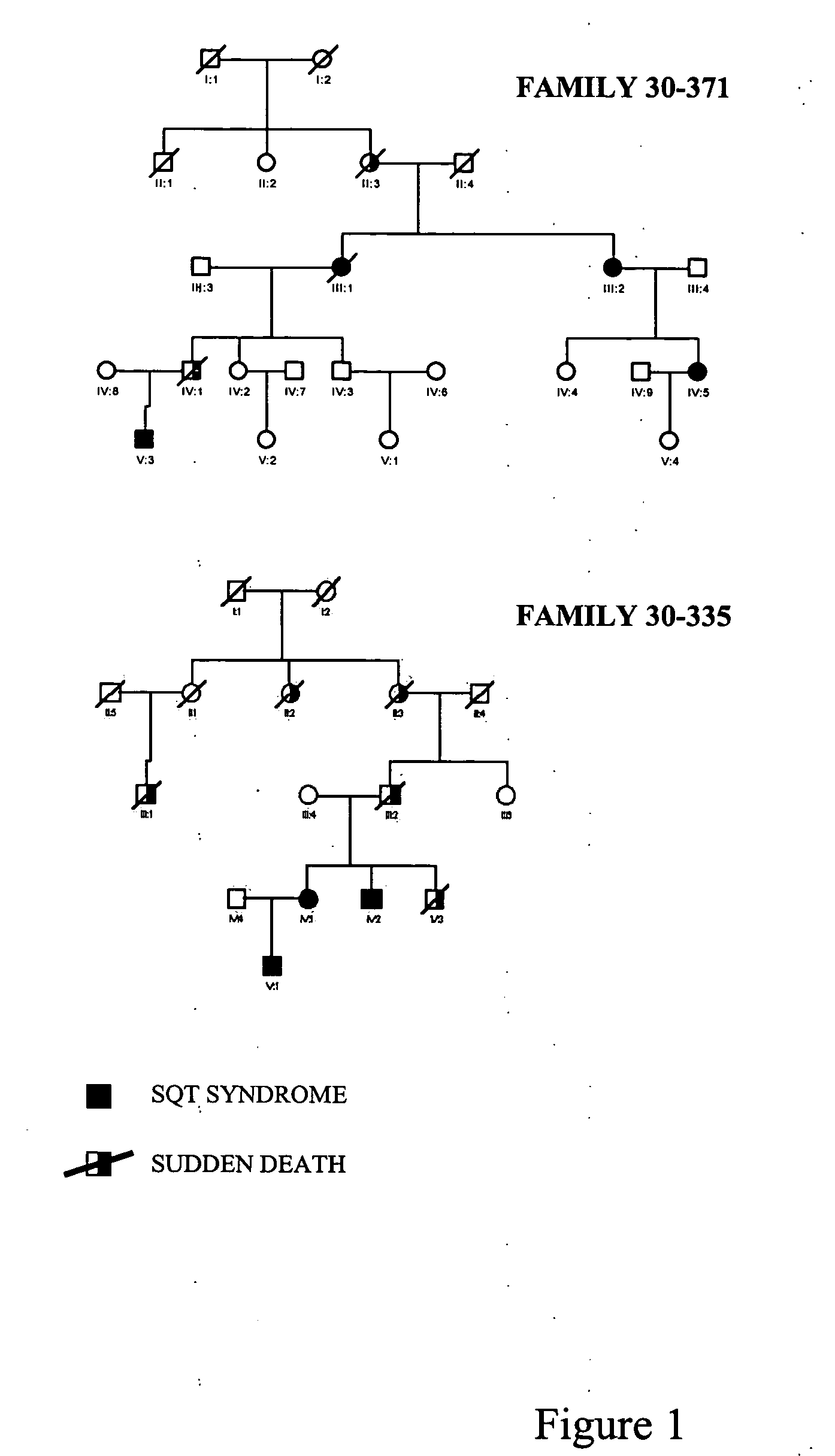Mutations in ion channel proteins associated with sudden cardiac death
a technology of ion channel proteins and mutations, applied in the field of diagnosis can solve the problems of high risk of sudden cardiac death, syncope or sudden death, heterogeneous abbreviation of action potential duration and refractoriness, and achieve the effect of determining susceptibility to cardiac death
- Summary
- Abstract
- Description
- Claims
- Application Information
AI Technical Summary
Problems solved by technology
Method used
Image
Examples
example i
KCNH2 Mutations
[0099] Family 30-371 (FIG. 1), having 23 members, displayed a high incidence of sudden death. The proband (III-2) was referred due to frequent palpitations. Her ECG displayed a QT interval of 270 msec. Her daughter (IV-5) had a QT interval of 260 msec, but was asymptomatic. The proband's nephew (V-3) had a history of syncope and had a QT interval of 240 msec. The proband's sister (III-1), who had a QT of 210 msec and suffered from atrial fibrillation, died suddenly at age 62; her mother (II-3) died suddenly at age 45 and her nephew died suddenly with documented ventricular fibrillation at age 26 (IV-1). Eight living family members underwent a complete physical examination and a 12-lead ECG as part of their initial clinical work-up. Three presented with a short QT interval and were evaluated with additional tests, including MRI. Two of the affected individuals underwent an electrophysiological study.
[0100] Family 30-335, having 16 individuals,...
example ii
SCN5A and KCNQ1 Mutations
[0107] Genomic DNA was isolated from peripheral blood leukocytes using a commercial kit (Gentra System, Puregene). Haplotype segregation analysis was performed in family 30-371 by amplification of highly polymorphic markers (Linkage mapping set 2.5 Applied Biosystems) flanking the candidate genes with the use of polymerase chain reaction (PCR). Those genes that were segregating with the affected individuals were further analyzed.
[0108] The exons of SCN5A and KCNQ1 were amplified and analyzed by direct sequencing using the primers set forth below. PCR products were purified with a commercial reagent (ExoSAP-IT™, USB) and were directly sequenced from both directions with the use of ABI PRISM 3100-Avant™ Automatic DNA Sequencer.
Seq.Id.No.PRIMERS FORSCN5A SCREENINGSCN5A EXON 2GGTCTGCCCACCCTGCTCTCT9SENSESCN5A EXON 2CCTCTTCCCCCTCTGCTCCATT10ANTISENSESCN5A EXON 3AGTCCAAGGGCTCTGAGCCAA11SENSESCN5A EXON 3GGTACTCAGCAGGTATTAACTGCAA12ANTISENSESCN5...
example iii
Correlation of Gene Mutation to Syndrome
[0110] Using the techniques described above, the following mutations were shown to correspond with the indicated clinical conditions:
PatientFAMILYChannelExonAminoacid positionBRUGADA SYNDROMERB490124-310SCN5A28C1727 RRB514524-345SCN5A3R104WRB503724-328SCN5A16insertionTG (851)RB466524-064SCN5A16R878CRB515124-JPN3SCN5A12F532CRB601124-365SCN5A16L917RRB613033-433SCN5A6, 22V232I + L1307FRB05424-011SCN5A27splice28deletion(E1573-G1604)RB502924-284SCN5A14A735VRB623724-483SCN5A27E1573KRB602624-372SCN5A5R179 stopRB617925-440SCN5A10E446KRB618125-442SCN5A10G400ARB626724-492SCN5A16H886PRB604224-347SCN5A9, 28P336L, I1659VRB406024-096SCN5A28Y1614 stop codonRB4510SCN5A6T220ILONG QT SYNDROMERB602425-JPN1KCNQ13G189WRB630125-499KCNH25R356HRB608725-387SCN5A19S1134IRB618825-449KCNH29C deletion (764)RB619425-454KCNH26W398stopcodonSHORT QT SYNDROMERB601930-371KCNH27N588KPROGRESSIVE CONDUCTION DISEASERB632525-510SCN5A17P1008S
PUM
| Property | Measurement | Unit |
|---|---|---|
| mid-inactivation voltage | aaaaa | aaaaa |
| temperature | aaaaa | aaaaa |
| pH | aaaaa | aaaaa |
Abstract
Description
Claims
Application Information
 Login to View More
Login to View More - R&D
- Intellectual Property
- Life Sciences
- Materials
- Tech Scout
- Unparalleled Data Quality
- Higher Quality Content
- 60% Fewer Hallucinations
Browse by: Latest US Patents, China's latest patents, Technical Efficacy Thesaurus, Application Domain, Technology Topic, Popular Technical Reports.
© 2025 PatSnap. All rights reserved.Legal|Privacy policy|Modern Slavery Act Transparency Statement|Sitemap|About US| Contact US: help@patsnap.com



